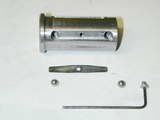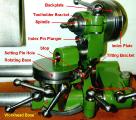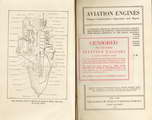Editorial
April has been a busy month here with nothing to show for it. The Cirrus Mk 1 remains mount-less and all the other unfinished projects are just as unfinished. The Humbug has undergone a revision to further simplify construction, and I've produced more words for this issue that I had intended—so what's new, you ask.
 As for the wet April that the forecasters promised, what can I say? How about this: Not. A. Drop. Zero. Nil. None! Not in Brisbane anyway. Farmers in the south of the continent got a whole 25mm (an inch) on the last day of April. They seem to be pleased, but say that they need follow-up though. One I heard interviewed said he has a whole mob of sheep that have never seen rain before. And our state government is now saying that the plant which will deliver recycled water to the Brisbane reservoir system in late 2008 will not meet the projected flow because the good citizens have significantly decreased their water consumption so there's no water to recycle—this reduction took place under government direction, naturally. The picture shows the Wivenhoe dam that supplies water to Brisbane. It's a short, failed DT away from our free-flight field, so some retrievals may be easier than before. Oh well, on to business...
As for the wet April that the forecasters promised, what can I say? How about this: Not. A. Drop. Zero. Nil. None! Not in Brisbane anyway. Farmers in the south of the continent got a whole 25mm (an inch) on the last day of April. They seem to be pleased, but say that they need follow-up though. One I heard interviewed said he has a whole mob of sheep that have never seen rain before. And our state government is now saying that the plant which will deliver recycled water to the Brisbane reservoir system in late 2008 will not meet the projected flow because the good citizens have significantly decreased their water consumption so there's no water to recycle—this reduction took place under government direction, naturally. The picture shows the Wivenhoe dam that supplies water to Brisbane. It's a short, failed DT away from our free-flight field, so some retrievals may be easier than before. Oh well, on to business...
NAMES 2007

The 18th North American Model Engineering Society Exposition was held over April 21-22 at the Seagate Convention Center in Toledo, Ohio. With 50,000 square feet of sights to see, Model Engine News Member, Don Belote, took advantage of set-up day and pre-opening times to charge around taking photos of the Internal Combustion engine exhibits (plus a couple of ring-ins  ). Don took a *lot* of photos, so the NAMES 2007 page has lots to see. The variety is vast and I'll bet everyone has a different favorite. Mine would be this Leja four-stroke replica. For more details about this engine, see the Feeney Story.
). Don took a *lot* of photos, so the NAMES 2007 page has lots to see. The variety is vast and I'll bet everyone has a different favorite. Mine would be this Leja four-stroke replica. For more details about this engine, see the Feeney Story.
UPT Tooling

I've received a couple of emails asking when I'm going to get back to the Universal Pillar Tool construction series. Good question. Having several shots on file awaiting words and some more action, the table has been calibrated using the tool itself (software engineers just love things that can bootstrap themselves into something better). This photo shows the holder for 1/4" square number and letter punches that will keep them nicely aligned while defacing innocent pieces of metal. Its construction and use are described on the UPT Tooling page, along with the very important and annoying little thing I discovered about el-cheapo punches in the process.
A Plea from eNZed

If you go back to the March 2005 issue of Model Engine News, you'll see the eighteen cylinder Gnome Rotary that New Zealander, Murray Lane, has been researching and building. Murray has written to say he is making progress (and scrap), but in his on-going pursuit for authenticity, he is after a copy of a rather obscure French publication that he hopes will help. The book title is:
'Les Moteurs A Pistons Aeronautiques Francais
(1900/1960) by Alfred Bodemer & Robert Laugier.
It was printed in 1978 and Murray thinks that there may be two volumes. He has scans but they are difficult to read, so he'd like to buy an original. If you can help, Murray's email is lanemjk@slingshot.co.nz. You can see new photos of progress on the cylinders and valve cages in Page 10 of the Engine Gallery.
Radial

Also new in the Gallery is a set of photos showing the 38cc, five cylinder radial made by Australian, Ken Dines. Looking for something to do on retirement, Ken made a "Simplex" live-steam loco and a four cylinder four-stroke. Becoming intrigued by Internal Combustion engines, Ken decided to make a five cylinder radial just to see how they worked (less ambitious folk would read a book). Ken's engine is now finished and running. You can find photos in The Gallery. And I bet Ken now knows a LOT about how radial engines work!
Why is it called the QUORN?

Assuming you don't have to ask What's a QUORN?, the next question is generally Why is it called that?! Having been asked this question a couple of times and discovered that the answer cannot be found on the Web, a new Tribute Page to Professor Dennis H Chaddock has been added to the Model Engineering section. As you may have guessed, DHC was the designer of the QUORN and the reason why it is called what it is called will be found buried somewhere amongst the remarkable list of his contributions and accomplishments.
Clanford Again

Remember Clanford's Pictorial A-Z featured as the Book of the Month last month? I had a dim suspicion that it may have been reprinted. If I'd spent five seconds doing a Google search, I'd have been able to let you all know that it can be bought for the princely and affordable sum of £20.00 over the Internet from Ben Buckle Kits in the UK. This is like, way less than I paid, and way, way less than originals are now changing hands for. As seen here, the reprint has a purple cover, but is supposed to be identical in other respects. I've not eye-balled a copy, so I can't positively attest to this. Rather depends on whether it was made from original masters, or a cut up copy. I'd guess you get all the original errors as well, but at least you won't have to visit your bank manager first and you get a free vintage plan as well (and thanks to the reader who emailed with this information).
Updates and Corrections
We try to be as accurate as possible with the background to model engines described on this site. If this means writing a paragraph where a sentence would do, then by golly, two paragraphs get written! The great thing about the web is the lack of work-count restrictions. The trick is to strike a balance between content length and not boring the reader into wandering away from the site. But the source material is frequently sourced from magazine articles that were under very strict word limits and so detail may be a bit light on. After a topic has been chosen and researched, the results from the Literature are supplemented with detail from the collective wisdom of the Motor Boys Group. Still, inaccuracies can happen so I'm always overjoyed when someone emails with direct information that enables an error to be corrected. I'm a trusting kind of guy, so if it sounds reasonable and appears genuine, an update is made (I've been sitting on some brilliant new information on Mills Brothers engines that will get put together Real Soon Now and challenge some established "wisdom").
 So it was great to receive an unexpected email from Carl Kendall whose father was Walter Kendall, the designer and manufacturer of the Marown Engineering (ME) Heron and Snipe. Seems we had the involvement of Mr Peter (PMC Imp) Moore with ME wrong. Revisit the ME Heron page and re-read the first paragraph that corrects the involvement of Peter Moore with Walter Kendall and should satisfy any curiosity regarding what Marown Engineering did after engine making.
So it was great to receive an unexpected email from Carl Kendall whose father was Walter Kendall, the designer and manufacturer of the Marown Engineering (ME) Heron and Snipe. Seems we had the involvement of Mr Peter (PMC Imp) Moore with ME wrong. Revisit the ME Heron page and re-read the first paragraph that corrects the involvement of Peter Moore with Walter Kendall and should satisfy any curiosity regarding what Marown Engineering did after engine making.
Next, new photos and information from readers on the Continent have led to updates of the Movo D2 and SiM 2b pages. As usual, one thing leads to another and the Movo page (previously just a single picture) now has some information regarding the Movo D1 and Movo 10cc diesel. If anyone has an actual D1, we'd love a photo of it.

Finally, The mystery surrounding the Drome Demon, last month's Watzit, has deepened. Ron Moulton emailed with information regarding the only advertisement of the engine to ever appear in the Aero Modeller. Aside from calling the Demon "The Greatest Scientific Achievement of the Century" (gutsy call, that), the ad appeared in February 1946. This date conflicts with both Clanford and Fisher who place it much earlier, even if they can't agree when. Great. Now everyone is confused.
New Books and Magazines This Month

An alert reader emailed during the past month to let me know about a book called Aviation Engines by First Lieut. Victor W Pagé, published by The Norman W Henley Publishing Company, New York, 1918 (no ISBN  ). As it happened, I have a copy in The Library that I found in an antique store in the Napa Valley and paid $100 for about ten years back. Well now all of you can have a copy too, for free! This rather rare book and many others have been scanned and placed on line by the Internet Library. This on-line library—of which I'm ashamed to say I was totally ignorant—contains texts, audio, music and moving images for scholarship and research purposes only. But what about copyright, you ask? Read the full and surprisingly uncomplicated Terms of Use page if you are curious. I've not yet been able to locate enough spare moments to rub together and investigate this collection in depth, but it appears that one could spend hours and hours and hours here.
). As it happened, I have a copy in The Library that I found in an antique store in the Napa Valley and paid $100 for about ten years back. Well now all of you can have a copy too, for free! This rather rare book and many others have been scanned and placed on line by the Internet Library. This on-line library—of which I'm ashamed to say I was totally ignorant—contains texts, audio, music and moving images for scholarship and research purposes only. But what about copyright, you ask? Read the full and surprisingly uncomplicated Terms of Use page if you are curious. I've not yet been able to locate enough spare moments to rub together and investigate this collection in depth, but it appears that one could spend hours and hours and hours here.

Back to the Pagé book. It covers theory, construction, and maintenance of aircraft engines from the period up to and including the Great War. The text is copiously illustrated with photographs and very well detailed line drawings. My physical copy was censored, so I was curious to see if the on-line copy could provide the missing sections like that seen in the first picture. Sadly, the on-line copy has been made from a censored edition as well. This scan shows the insert that warns the buyer of this. The insert is absent in the on-line copy.

Scale engine builders will find a wealth of detail in this book. There are no dimensioned drawings, but the detail of constructional and operational details of such engines as the Gnome and Le Rhone rotaries answer a lot of questions. The question that remains is what was the basis for the censoring? It appears that Washington felt that parts of the sections relating to German designed engines was not meant for American citizens to know. I'd have thought that detailed knowledge of what the opposition designers were up to would be of intense interest to readers of this book (First Lieut. Pagé is listed as Assistant Engineering Officer, Signal Corps Aviation School, Mineola, Long Island). And being at war, it does not seem all that likely that issues of copyright drove the censorship, but who knows? People were a lot more formal and proper in those days.
The URL for the on-line book is:
http://www.archive.org/details/aviationenginesd00pagrich.
From this page, you can download versions as PDF or Text. There's even a rather nice access format called FlipBook that is just like turning the pages—they even animate the action! I read a lot of on-line documents in my day-job and subscribe to a service that allows be to read all of publisher O'Reilly on-line. It works ok, but balancing the laptop on my tummy in bed late at night is just not the same thing. Guess I'm just a hopeless dinosaur...
Engine Of The Month: ED Hornet

This month we'll have a close and personal look at the ED Hornet 1.46cc diesel. The selection arose through refinement of the Humbug design to make things as simple as possible for first time builders. For a simple and inexpensive engine, I'd always though of the Hornet as a real screamer. Now I know why. As we'll see in this month's review of the ED Hornet, the simple design ED chose led to a rather unusual timing that should impact performance, but perversely, doesn't!
Tech Tip of the Month

One of the most frequently asked questions this site receives in emails relates to what ingredients go into "diesel fuel", and is there any substitute for ether? There are no dumb questions and the Internet is a great place to find answers. To make this data more available through search engines, a FAQ entry about diesel fuel was created. This blossomed to FIVE entries relating to running diesel engines and making diesel fuel, all of them genuine—not a single Dear Dorothy Dix'er amongst them—but still the questions come! Obviously Google needs to be primed with more phrases relating to model engine fuel ingredients.
Last month, while looking for something else entirely, I rediscovered an article on model engine fuels in a 1950 Aero Modeller that goes further into the subject than any I've seen anywhere before, or since. It contains tables giving things like the Self Ignition Temperature (SIT) and calorific values for common fuel ingredients and goes on to explain the whys and wherefores most clearly. This information has been scanned, OCR'd, and laid out as a web page that should answer just about every question on diesel, glow, and spark ignition fuels that you ever thought of and a several more you didn't. Finding an appropriate location to index the page from was harder than converting it to HTML. According to monthly stats, the FAQ does not get the workout that it should, so the treatise by FCB Marshall on model engine fuels has been linked into the How-To index. I believe that the material has not "dated" significantly as while there have been advances in lubrication in the past half-century, the stuff that goes bang has not changed, except perhaps in availability!
 NAMES 2007
NAMES 2007
 UPT Tooling
UPT Tooling
 A Plea from eNZed
A Plea from eNZed
 Radial
Radial
 Why is it called the QUORN?
Why is it called the QUORN?
 Clanford Again
Clanford Again
 Updates and Corrections
Updates and Corrections
 Editorial
Editorial
 New and Updated Pages
New and Updated Pages
 New Books and Magazines This Month
New Books and Magazines This Month
 Engine Of The Month: ED Hornet
Engine Of The Month: ED Hornet
 Tech Tip of the Month
Tech Tip of the Month
 Standard Stuff
Standard Stuff


 ). Don took a *lot* of photos, so the
). Don took a *lot* of photos, so the 










